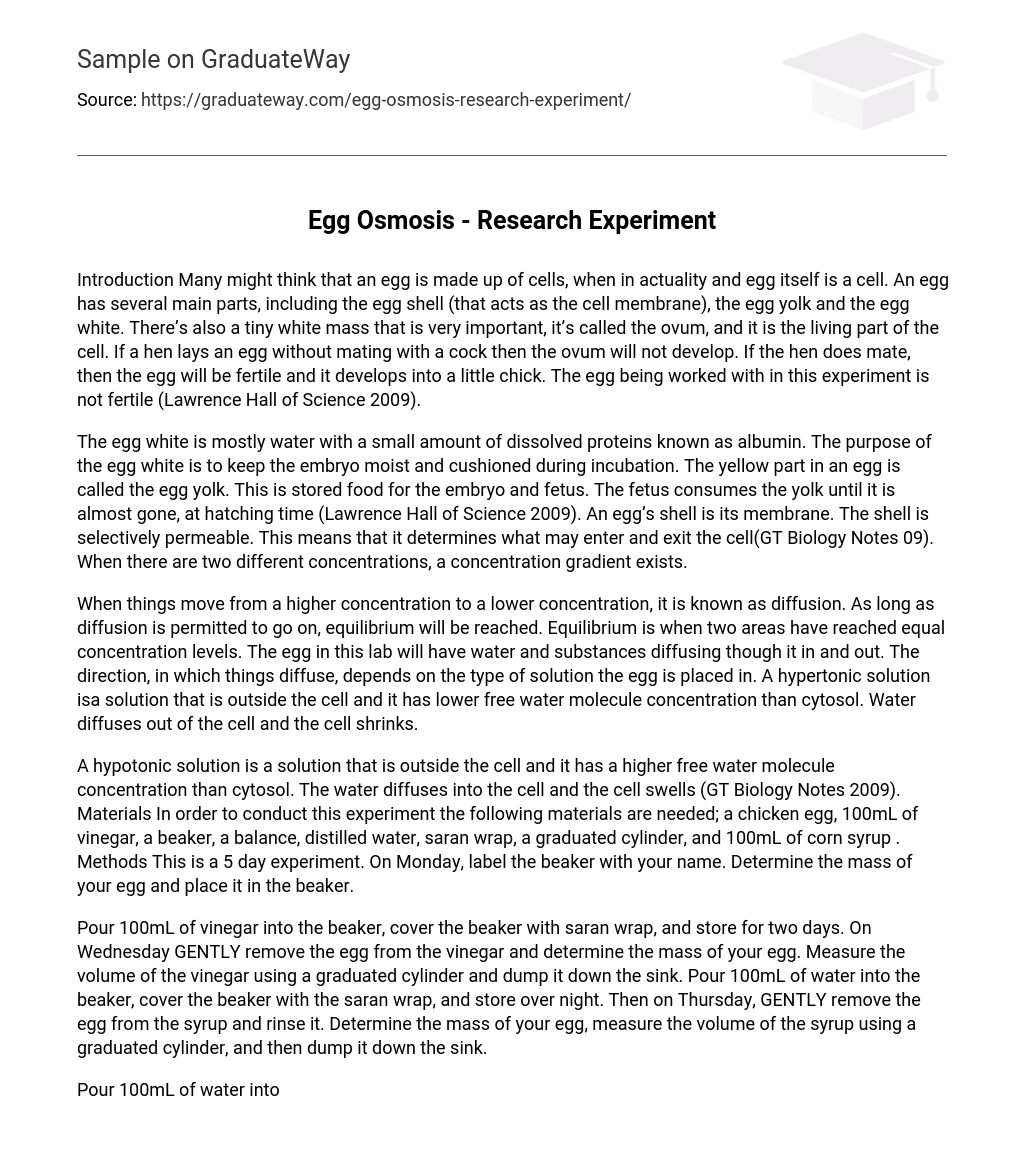Introduction: The egg is often misunderstood as being made up of multiple cells, when in fact it is a single cell. It consists of important components such as the egg shell (which acts like the cell membrane), egg yolk, and egg white. The ovum, a small white mass, is vital to the living part of the cell. If a hen lays an unfertilized egg, the ovum will not develop. However, if the hen successfully mates with a rooster, the egg becomes fertile and develops into a baby chick. In this experiment, we are using an infertile egg (Lawrence Hall of Science 2009).
The egg white, also known as albumin, is primarily composed of water and serves to keep the embryo moist and cushioned during incubation. On the other hand, the egg yolk is the stored food for the embryo and fetus. The yolk is consumed by the fetus until hatching. The egg’s shell, or membrane, is selectively permeable, determining what substances can enter and exit the cell. When there are varying concentrations, a concentration gradient is present (Lawrence Hall of Science 2009; GT Biology Notes 09).
Diffusion is the movement of substances from a higher concentration to a lower concentration. This process continues until equilibrium is achieved, which occurs when two areas have equal concentration levels.
This lab involves an egg that permits water and substances to diffuse in and out of it. The direction of diffusion relies on the solution type in which the egg is immersed.
When the egg is placed in a hypertonic solution (a solution outside the cell with lower free water molecule concentration than cytosol), water diffuses out of the cell, resulting in its shrinkage.
According to GT Biology Notes 2009, a hypotonic solution is defined as an external solution that has a higher concentration of free water molecules compared to the cytosol. This particular solution causes the cell to undergo swelling as water diffuses inside.
In order to carry out the experiment, you will require several materials including a chicken egg, 100mL of vinegar, a beaker, a balance, distilled water, saran wrap, a graduated cylinder, and 100mL of corn syrup.
The duration of the experiment spans five days. On Monday, it is essential to affix your name on the beaker and establish the mass of your egg before placing it in said beaker.
Follow these steps for the experiment:
1. Pour 100mL of vinegar into a beaker, cover it with saran wrap, and store it for two days.
2. On Wednesday, carefully remove the egg from the vinegar and weigh it.
3. Use a graduated cylinder to measure the volume of the vinegar and dispose of it in the sink.
4. Replace the vinegar with 100mL of water, cover it with saran wrap, and store it overnight.
5. Then, on Thursday, gently take out the egg from the syrup, rinse it off, and determine its mass.
6. Measure the volume of the syrup using a graduated cylinder and discard it in the sink.
Pour 100mL of water into the beaker, cover it with saran wrap, and store overnight. On Friday, gently remove the egg from the water and determine its mass. Measure the volume of the water using a graduated cylinder and dispose of it down the sink.
Results: The initial vinegar amount was 100mL and decreased to 73mL, resulting in a total change of 27mL. The initial egg mass was 58.40 while the final mass was 78.6, indicating an increase of 20.20 in mass. In terms of syrup, its initial amount was 100mL and increased to 114.5mL, showing a rise by 14.5 mL. The initial egg mass for this case was initially at 78g but decreased to then reach a final mass of56 .7g; representing a decrease in weight by21 .8g.Theinitialwaterquantitywasof100 mLanddecreasedto42 mL,resultinginachangeof58 mL.Finally,theegg’sinitialmasswas56 .7gwhilethefinalmasswasthen81 .5g.Thisresultedinanincreaseinweightby33 .8(Table1).
Graphs and Tables * Table1*: Changes in themassoftheeggandthesolution
Discussion/Conclusion: The reason behindtheegg’sgaininmasswhensoakedinvinegaristhatvinegarisahypotonicsolutionfortheegg.Meaningthattherearefewersolutesdissolved(morefreewatermolecules)inthvintarcomparedtoinside.theegg.
After being soaked in vinegar for two days, the egg experiences molecular movement to achieve equilibrium. Consequently, water from the vinegar infiltrates the egg, resulting in an enlargement and increase in mass. This confirms the hypothesis that soaking the egg in vinegar would cause it to expand and gain weight. Next, the egg is submerged in syrup with a higher concentration of dissolved solutes compared to the egg itself. As a result, the syrup acts as a hypertonic solution for the egg. Since there are more dissolved solutes and fewer free water molecules present, water within the egg diffuses out into the syrup until equilibrium is reached.
The hypothesis that the egg’s mass will decrease when placed in syrup was confirmed during this part of the experiment. However, there were some errors in the procedure that could have influenced the results. For example, there was still vinegar remaining in the graduated cylinder when introducing the syrup, and a similar situation may have occurred with the cup. Additionally, it is possible that the duration of time spent by the egg in both syrup and vinegar was not precisely equal. While these factors may have had a minor effect on the outcome, it is feasible to enhance the experimental protocol further.
The directions for the experiment could have been clearer. It would have been helpful to include the instruction to put the egg back into the cup after pouring out the used solution down the sink. This instruction could have been placed either before or after step four, on all days except for Friday. To improve the lab, it could have benefited from more trials.
Works Cited “Chicken Eggs. ” Fossweb. Lawrence Hall of Science, 31 July 2009. Web. 6 Dec. 2009. http://lawrencehallofscience.org/?foss/?fossweb/?teachers/?materials/?plantanimal/?chickeneggs.html.
Jong, “Biology Notes.” Memo to Biology Class. 2009. TS.
Jong, “Egg Osmosis Lab.” Memo to Biology Class. 2009. MS.





